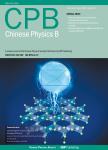Giant magnetocaloric effect in the Gd_5 Ge_(2.025)Si_(1.925)In_(0.05) compound
Giant magnetocaloric effect in the Gd_5 Ge_(2.025)Si_(1.925)In_(0.05) compound作者机构:Department of Engineering PhysicsFaculty of EngineeringAnkara University06100 BesevlerAnkaraTurkey
出 版 物:《Chinese Physics B》 (中国物理B(英文版))
年 卷 期:2010年第19卷第3期
页 面:517-522页
核心收录:
学科分类:0809[工学-电子科学与技术(可授工学、理学学位)] 07[理学] 070205[理学-凝聚态物理] 08[工学] 0805[工学-材料科学与工程(可授工学、理学学位)] 080502[工学-材料学] 0702[理学-物理学]
基 金:supported by Ankara University Research Funds (Grand Number:BAP 06B4343004)
主 题:magnetic properties magnetocaloric effect isothermal magnetic entropy change adia-batic temperature change
摘 要:The magnetocaloric properties of the GdsGe2.025Si1.925In0.05 compound have been studied by x-ray diffraction, magnetic and heat capacity measurements. Powder x-ray diffraction measurement shows that the compound has a dominant phase of monoclinic Cd5Ge2Si2-type structure and a small quantity of Gds(Ge,Si)3-type phase at room temperature. At about 270 K, this compound shows a first order phase transition. The isothermal magnetic entropy change (△SM) is calculated from the temperature and magnetic field dependences of the magnetization and the temperature dependence of MCE in terms of adiabatic temperature change (△Tad) is calculated from the isothermal magnetic entropy change and the temperature variation in zero-field heat-capacity data. The maximum △SM is -13.6 J·kg^-1.K^- 1 and maximum ATad is 13 K for the magnetic field change of 0 5 T. The Debye temperature (θD) of this compound is 149 K and the value of DOS at the Fermi level is 1.6 states/*** from the low temperature zero-field heat-capacity data. A considerable isothermal magnetic entropy change and adiabatic temperature change under a field change of 0-5 T jointly make the Gd5Ge2.025Si1.925In0.05 compound an attractive candidate for a magnetic refrigerant.



